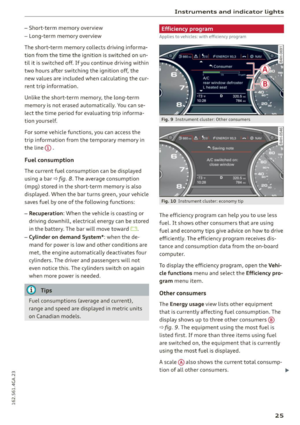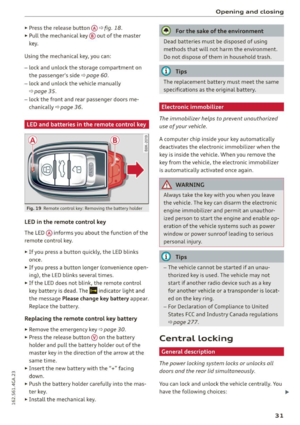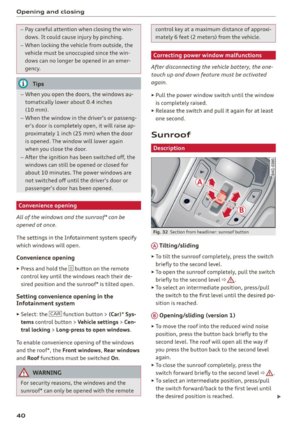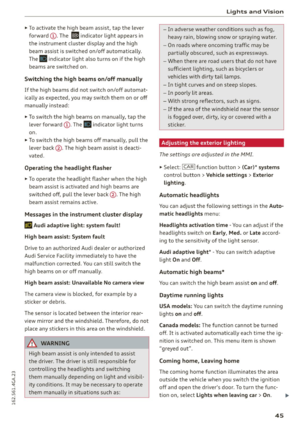Page 249 of 294

-Tires on a vehicle that has
been overloaded can fail sud
denly, including a blowout and
sudden deflation, causing loss
of control and a crash.
-Always make sure that the to
tal load being transported - including the weight of a trail
er hitch and the tongue
weight of a loaded trailer -
does not make the vehicle heavier than the vehicle's
Gross Vehicle Weight Rating.
Determining correct load
limit
Use the example below to calcu
late the total weight of the pas
sengers and luggage or other
things that you plan to transport so that you can make sure that
your vehicle will not be overload
ed.
Steps for Determining Correct Load Limit
1. Locate the statement "THE
COMBINED WEIGHT OF OCCU
PANTS AND CARGO SHOULD
NEVER EXCEED XXX KG OR XXX
LBS"on your vehicle's placard
(tire inflation pressure label)
¢ page 243, fig. 19 7.
Wheels
2. Determine the combined
weight of the driver and pas
sengers that will be riding in
your vehicle.
3. Subtract the combined weight
of the driver and passengers
from
"XXX" kilograms or "XXX"
pounds shown on the sticker
¢ page 243, fig . 197 .
4. The resulting figure equals the
available amount of cargo and
luggage load capacity. For ex
ample, if the
"XXX" amount
equals
1400 lbs. and there will
be five
150 lbs. passengers in
your vehicle, the amount of
available cargo and luggage
load capacity is 650 lbs .
(1400-750 (5 X 150) = 650
lbs.)
5. Determine the combined
weight of luggage and cargo
being loaded on the vehicle.
That weight may not safely ex ceed the available cargo and
luggage load capacity calculat
ed in Step 4.
6. If your vehicle will be towing a trailer, load from your trailer
will be transferred to your vehi
cle. Consult this manual to de
termine how this reduces the ..,
247
Page 250 of 294

Wheels
av ailabl e cargo and luggag e
l oa d cap aci ty of your v ehi cle.
.,.Che ck th e tire sidew all
(¢ p ag e 233, fig. 1 9 5) to deter
mine the d esigna ted load ra ting
for a specifi c tire .
Wheel bolts and rims
Wheel bolts
Wheel bol ts m ust be clea n and loosen/t ighten
easi ly .
R ims
Rims with a bolted rim r ing* or w ith bolted wheel
covers * consist of mu ltiple piec es. These compo
nents we re bo lted toget he r us ing special bolts
a nd a special pro cedure. You must no t repair or
d isassemble th em ¢.&. .
A WARNING
Whee l bolts t hat are tightened or repaired in
co rrectly can become loose and resu lt in loss
o f vehicle control, which increases the risk of
an acc ident. For the correct tightening specifi
cat ion, refer to
¢ page 2 56, After changing a
wheel .
-Always keep the wheel bolts and the threads
in the wheel hub clean and free of grease .
- Only use wheel bo lts that fit the r im .
- Always have damaged rims repa ired by an
autho rized Aud i dealer or authorized repair
facility. Never repair or disassemble rims
you rself, because this increases the risk of
an acciden t.
Winter tires
Winte r tires sign ificantly improve the ve hicle's
handling when d riving i n w inte r condit io ns. Be
cause of the ir constr uction (wid th, compo und,
trea d patter n), s umme r tires p rov ide less tract ion
on ice and snow .
.,. Use w inte r tir es on all fou r wheels.
248
.,. On ly use winter tires that are approved fo r yo ur
vehicle.
.,. Please note that t he maxim um permitted
speed may be lower with winter tires ¢
_A .
Your authorized Audi dealer or authorized re
pair faci lity can inform you about the maximum
perm itted speed for your ti res .
.,. Check the tire pressure afte r instal ling whee ls
¢ page 243.
The effect iveness of w inter t ires is red uced great
ly when the tread is worn down to a dep th of
0.1 57 i nch ( 4 mm). The cha racterist ics of winter
ti res a lso de crease grea tly as the t ire ages, re
gardless of the remaining tre ad.
A WARNING
-
- Never drive faster than the max imum pe r
m itted speed for your tires. This co uld cause
the t ires to heat up too much . This increases
the risk of an accident because it can cause
the t ire to burst.
- Always adapt your dr iving to the road and
traffic cond itions. D rive carefully and reduce
your speed on icy or slippe ry roads. Even
win ter t ires ca n lose traction on black ice.
@ For the sake of the environment
Reinstall summer tires at the appropriate
time, beca use they provide better handling
when roads are free of snow and ice . Summer
tires cause less road noise, tire wear and fuel
consum ptio n.
(D Tips
You can a lso use all season tires instead of
winter tires. Please note that in some coun
tries where w inter t ires a re requir ed, only win
ter tires w ith the£ symbol may b e permit
ted.
' Snow chains
Snow chains improve traction in the snow .
.,. On ly install snow chai ns on the front w heels.
T his app lies also to vehicles with all wheel
dr ive*.
Page 251 of 294

M N <( (.J
'SI: ,...., \!) 1.1'1
N \!) ,....,
~ Check and correct the seating of the snow
chains if necessary after driving a few feet. Fol
low the instructions from the manufacturer.
~ Note the maximum permitted speed when driv
ing with snow chains. Do not exceed 30 mph
(SO km/h) .
Snow chains not only improve the driving in win
ter road conditions, but also the braking.
Use of snow chains is only permitted with certain
rim/tire combinations due to technical reasons.
Check with an authorized Audi dealer or author
i z ed repair facility to see if you may use snow
chains .
You must remove the chains when driving on roads that are free of snow. When roads are free
of snow, snow chains can impair handling and
damage the tires, and the chains will quickly be
destroyed.
A WARNING
Using incorrect snow chains or installing snow
chains incorrectly can result in loss of vehicle
control, which increases the risk of an acci
dent.
- Snow chains can damage the rims/wheel
covers* if the chains come into direct con
tact with them. Remove the wheel covers*
first. Use coated snow chains.
- Using snow chains that add more than 0 .4
inch (10.5 mm) of height can severely dam
age the wheel housings and other vehicle
components.
- Do not install and use snow chains if there is
a malfunction in the adaptive air suspen
sion*, because the vehicle height will be
very low. If you drive with snow chains any
way, the wheel housings and other vehicle
components can be severely damaged.
Low aspect ratio tires
Your Audi is factory-equipped with low aspect ra
tio tires . These tires have been thoroughly tested
and been selected specifically for your model for
Wheels
their superb performance, road feel and handling
under a variety of driving conditions. Ask your au
thorized Audi dealer for more details.
The low aspect ratio of these tires is indicated by
a numeral of
55 or less in the tire's size designa
tion. The numeral represents the ratio of the
tire's sidewall height in relation to its tread width
expressed in percentage. Conventional tires have
a heigh t/width ratio of 60 or more.
The performance of low-aspect-ratio tires is par
ticularly sensitive to improper inflation pres
sure. It is therefore important that low aspect
ratio tires are inflated to the specified pressure
and that the inflation pressure is regularly
checked and maintained. Tire pressures should be checked at least once a month and always
before a long trip
~ page 2 43.
What you can do to avoid tire and rim
damage
Low aspect ratio tires can be damaged more easi
ly by impact with potholes, curbs , gullies or
ridges on the road, particularly if the tire is un
deri nflated.
In order to minimize the occurrence of impact
damage to the tires of your vehicle, we recom
mend that you observe the following precau
tions:
- Always maintain recommended inflation pres
sures. Check your tire pressure every 2,000
miles (3 ,000 km) and add air if necessary.
- Drive carefully on roads with potholes , deep
gullies or ridges. The impact from driving
through or over such obstacles can damage
your tires. Impact with a curb may also cause
damage to your tires.
- After any impact, immediately inspect your
tires or have them inspected by the nearest au
thorized Audi dealer. Replace a damaged tire as
soon as possible.
- Inspect your tires every 2,000 miles (3,000 km)
for damage and wear. Damage is not always
easy to see . Damage can lead to loss of air and
underinflation, which could eventu ally cause
tire failure . If you believe that a tire may have
been damaged, replace the tire as soon as pos -
sible . .,.
249
Page 252 of 294

Wheels
-These tires may wear more quickly than others .
- Please also remember that, wh ile these ti res
deliver responsive handling, they may ride less
comfortably and make more noise than other
choices.
Reduced performance in winter/cold season
conditions
All tires are designed for certain purposes. The
low aspect ratio, ultra high performance tires
originally installed on your vehicle are intended
for maximum dry and wet road performance and handling. They are not suitable for cold, snowy or
icy weather conditions. If you drive under those
circumstances, you should equip your vehicle
with all-season or winter tires, which offer better
traction under those conditions. We suggest you
use the recommended snow or all-season tires
specified for your vehicle, or their equivalent.
Refer to ¢
page 248 for more detailed i nforma·
tion regarding winter tires .
Uniform tire quality grading
-Tread wear
- Traction AA A BC
- Temperature ABC
Quality grades can be found where applicable on
the tire side wall between tread shoulder and maximum section width¢
page 233, fig. 195 .
For example: Tread wear 200, Traction AA, Tern·
perature
A.
All passenger car tires must conform to Federal
Safety Requirements in addition to these grades.
Tread wear
The tread wear grade is a comparative rating
based on the wear rate of the tire when tested
under controlled conditions on a specified gov·
ernment test course.
For example, a tire graded 150 would wear one
and one half (11/2) times as well on the govern·
ment course as a tire graded 100.
The relative performance of tires depends upon
the actual conditions of their use, however , and
may depart significantly from the norm due to
250
variations in driving habits, service practices and
differences in road characteristics and climate.
Traction
The traction grades, from highest to lowest, are
AA, A, Band
C. Those grades represent the tire's
ability to stop on wet pavement as measured un
der controlled conditions on specified govern
ment test surfaces of asphalt and concrete. A tire
marked C may have poor traction performance
¢ _& .
Temperature
The temperature grades are A (the highest), B,
and C, representing the tire 's resistance to the
generation of heat and its ability to dissipate
heat when tested under controlled conditions on
a specified indoor laboratory test wheel.
Sustained high temperature can cause the mate·
rial of the tire to degenerate and reduce tire life,
and excessive temperature can lead to sudden
tire failure ¢& .
The grade C corresponds to a level of perform·
ance which all passenger car tires must meet un·
der the Federal Motor Vehicle Safety Standard
No. 109. Grades Band A represent higher levels
of performance on the laboratory test wheel than
the minimum required by law.
A WARNING
-
The traction grade assigned to th is tire is
based on straight-ahead braking traction
tests, and does not include acceleration, cor·
nering, hydroplaning or peak traction charac
teristics.
A WARNING
The temperature grade for this tire is estab
lished for a tire that is properly inflated and
not overloaded. Excessive speed, underinfla·
tion, or excessive loading, either separately or
in combination, can cause heat buildup and
-
possible tire failure. ..,_
Page 253 of 294

M N <( I.J "". rl I.O
"' N I.O rl
_& WARNING
Temperature grades apply to tires that are properly inflated and not over or underinflat
ed .
Tire pressure monitoring
system
CD General notes
Each tire, includ ing the spare (if provided),
should be checked monthly when cold and inflat
ed to the inflation pressure recommended by the
vehicle manufacturer on the vehicle placard or tire inflation pressure label. (If your veh icle has
tires of a different size than the size indicated on
the vehicle placard or tire inflation pressure la
be l, you shou ld determine the proper tire infla
tion pressure for those tires).
As an added safety feature, your vehicle has been
equipped with a tire pressure monitoring system
(TPMS) that illuminates a low tire pressure tell
tale when one or more of your tires is significant ly under -inflated. Accordingly, when the low tire
pressure telltale illuminates, you should stop and
check your tires as soon as poss ible, and inflate
them to the proper pressure. Driving on a signifi cantly under-inflated tire causes the tire to over
heat and can lead to t ire failure. Under-inflation
also reduces fuel efficiency and tire tread life,
and may affect the vehicle's handling and stop
ping ability .
Please note that the TPMS is not a substitute for
proper tire maintenance, and it is the driver's re
sponsib ility to ma inta in correct tire pressure,
even if under-inflation has not reached the level
to trigger illuminat ion of the TPMS low t ire pres
sure telltale.
Your vehicle has also been equ ipped with a TPMS
malfunction indicator to indicate when the sys
tem is not operating properly. The TPMS mal
function indicator is combined with the low tire
pressure telltale. When the system detects a
malfunction, the telltale will flash for approxi
mately one minute and then remain continuously
illuminated . This sequence will cont inue upon
Wheels
subsequent vehicle start -ups as long as the mal
function exists.
When the malfunction indicator is illuminated ,
the system may not be able to detect or signal
low tire pressure as intended . TPMS malfunctions
may occur for a variety of reasons, including the
i nsta llation of replacement or alternate tires or
wheels on the vehicle that prevent the TPMS
from functioning properly. Always check the
TPMS malfunction telltale after replacing one or
more t ires or wheels on your veh icle to ensure
that the replacement or alternate t ires and
whee ls allow the TPMS to continue to function
properly.
If the Tire Pressure Monitoring System
indicator appears
The tire pressure indicator in the instrument
cluster informs you if the tire pressure is too low
or if there is a system mo/function .
Fig. 199 Instrument cluster: indicator light with message
Using the ABS sensors, the tire pressure monitor
ing system compares the tire tread circumference
and vibration characteristics of the individual
tires . If the pressure changes in one or more
t ir es, this is indicated in the instrument cluster
display with an indicator light
HE and a message.
If only one tire is affected, the location of that
tire will be indicated.
T he tire pressures must be stored in the Infotain
ment system again each time the pressures
change (switching between partial and full load
pressure) or after changing or rep lacing a tire on
your vehicle
¢ page 252. The ti re pressure moni
toring system only monitors the tire pressure you have stored. Refer to the tire pressure label for ..,.
251
Page 254 of 294

Wheels
the recommended tire pressure for your vehicle
¢ page 243, fig. 198.
Tire tread ci rcumfe rence and v ibration character
istics can change and cause a tire pressure warn
ing if:
- the tire pressure in one or more t ires is too low .
- the tire has structural damage .
- the tire was replaced or the tire pressure was
changed and it was not stored
¢ page 252.
-the spare tire* is installed .
Indicator lights
IE Loss of pressure in at least one tire¢.&. .
Check the tires and replace or repair if necessary.
Check/correct the pressures of all four tires and
store the pressure again in the Infotainment sys
tem
¢page 252 .
mm (Tire Pressure Monitoring System) Tire pres
sure: System malfunction!. Ifffim
appears after
switching the ignition on or while driving and the
IE indicator light in the instrument cluster
blinks for approximately one minute and then
stays on, there is system malfunction . Try to
store the correct tire pressures¢ page 252. If
the indicator light does turn off or turns on again
after a short period of time, drive to your author
ized Audi dealer or authorized Audi Service Facili
ty immediately to have the malfunction correct
ed .
A WARNING
- If the tire pressure indicator appears in the
display, reduce your speed immediately and
avoid any hard steering or braking maneu
vers . Stop as soon as possible and check the
t ir es and their pressure .
- The driver is responsible for maintaining the correct tire pressure. You must check the
tire pressure regularly.
- Under certain conditions (such as a sporty
dr iving style, winter cond itions or unpaved
roads), the tire pressure monitoring system
indicator may be delayed.
- Do not use run-flat tires on your veh icle. Us
ing them when not permitted can lead to
vehicle damage or accidents.
252
(D Tips
-The tire pressure monitoring system can al
so stop working when there is an ESC mal
function.
- Using snow chains may result in a system
malfunction.
- The tires with the identification "AO" or
"RO" ¢
page 240 have been matched with
your Audi tire pressure monitoring system.
We recommend that you use these tires.
Storing tire pressures
If the tire pressure changes or a tire is replaced,
it must be confirmed in the Infotainment sys tem.
... Make sure before storing that the tire pressures
of all four tires meet the specified values and
are adapted to the load¢
page 243 .
... Switch the ignition on .
... Select: the
I CARI function button > (Car)* Sys
tems
control button > Servicing & checks > Tire
pressure monitoring
> Store tire pressures >
Yes, store now.
(D Tips
Do not store the tire pressures if snow chains
are instal led.
Page 255 of 294

M N <( I.J "". rl I.O
"' N I.O rl
Emergency assistance
Warning triangle
A pp lies to vehicles: Wi th wa rning tri angl e
D
\,-------:----- 11
Fig. 200 Luggage co mpa rtment l id : wa rnin g t ria n gle
The warning triangle p laced in the vehicle at the
factory is located in the luggage compartment .
• To open the cover, turn the locking mechanism
and pull the cover downward .
• Remove the warn ing triangle from its holder .
The luggage compartmen t lid is only designed to
hold the warning triangle offered by the original
accessories program .
Vehicle tool kit
Vehicle tool kit and jack
The vehicle tool kit is located in the luggage
comportment under the cargo floor cover .
Fig. 201 Lugg age co mpartment : ca rgo f loo r cover folded
up ward/ spa r e ti re
Em erg en cy ass is tan ce
Fig. 202 Trun k lid: Vehicl e too l kit
• Fold the floor to the seatback with the help of
t he hand le.
• Tu rn the handwheel counter-clockwise
r=;, fig. 201 and remove the spare tire to reach
the vehicle tool kit.
T he onboard tool kit includes :
- Hooks to remove the wheel covers*
- Plastic hook to remove wheel bol t covers"
- Wheel bolt wrench
- Alignment pin for changing wheels
- Screwdriver with reversib le b lade
- Tow ing eye
- Jack
Before storing the jack , make sure it is wound
back down as far as it will go .
A WARNING
'"' -Im proper use of the vehicle jack can cause se
rious pe rsonal injuries .
- Never use the screw driver hex head to
tighten wheel bolts, since the bolts cannot attain the necessary tightening torque if yo u
use the hex head, po ten tially causing an ac
cident.
- The fa ctory-supplied jack is intended only
for your ve hicle model. Unde r no circum
stances shou ld it be used to lift heavy
vehicles or other loads; you risk injuring
yourse lf.
- Never start the engi ne when the vehicle is
raised, which could cause an accident.
- Support the vehicle securely with appropri
ate stands if work is to be pe rformed under
neath the vehicle; otherwise, there is a po
tential risk for injury.
253
Page 256 of 294

Emerg enc y ass is tance
- Never use the jack supplied with your Audi
on another vehicle, particularly on a heavier
one. The jack is only suitable for use on the
vehicle it came w ith.
(D Tips
- Some of the on board items listed above are
provided on certain models only or are op
tiona l extras .
- Before you can raise your vehicle using the
jack, you must act ivate the jacking mode
c:> page257.
Space-saving spare tire {compact spare
tire)
The spare tire/wheel is located in the luggage
compartment under the cargo floor cover. It is
intended for short-term use only.
Taking out the sp are ti re
.,. Fo ld the floor to the seatback with the help of
the handle .
.,. Turn the large sc rew
c:> page 253, fig. 201 coun
te r-clockwise .
.,. Take out the spare tire .
.,. Always store the vehicle too l kit, the jack* and
the replaced tire in the luggage compartment
c:> page 132.
Using the spare tire (compact spare tir e)
The compact spare tire is only intended for emer
gen cies until you can reach a repair shop. Rep lace
it as qu ickly as possible with a standard wheel
and tire .
There are some rest rictions on the use of the
compact spare t ire. The compact spare t ire has
been designed specifically for yo ur type of vehi
cle.
It must not be swapped w ith a compact
spare tire from another type of vehicle.
Snow chains
F or technical reasons, the use of snow chains on
the compact spa re tire is
not permitted .
If you do have to drive w ith snow chains and a
front tire fails, mount the spare whee l w ith tire
instead of a rear t ire. Install the snow chains on
254
the rear t ire and use it to replace the defect ive
front tire.
A WARNING
- Never use the spare t ire if it is damaged or if
it is worn down to the tread wear indicators.
- If the spare tire is more than 6 years old,
use it only in an emergency and with ex
treme caution and careful driv ing.
- The spare tire is intended only for tempora
ry and short-term use.
It should be replaced
as soon as poss ible with the normal wheel
and tire .
- After mount ing the compact spare t ire, the
tire pressure must be checked as soon as
possible . The tire pressure of the compact
spare tire must be 4 .2 bar; otherwise, you
r is k havi ng an accident.
- Do not dr ive faster than SO mph (80 km/h) .
You risk hav ing an accident .
-Avoid full -thrott le acceleration, heavy brak
ing, and fast cornering . You risk hav ing an
accident .
- Never d rive us ing more than one spare
w heel and ti re . You r isk having an accident .
- Normal summer or w inter t ires must not be
mou nted on the compact spare wheel rim.
- For technical reasons , the use of tire chains
on the spa re tire is not permitted .
If it is
necessary to dr ive with tire chains, the spa re
w heel must be mounted on the front a xle in
t he event of a fla t in a re ar tire. The newly
avail able front whee l m ust th en be insta lled
in place of the rear wheel with the flat tire.
Insta lling the tire c hain before mounting
the whee l and tire is recommended.
- Loose items in the passenger compartment can cause se rious personal injury d uring
hard b raking o r in an accident. Never store
the inflatable spare t ire or jack and tools in
the passenge r compartment.
 1
1 2
2 3
3 4
4 5
5 6
6 7
7 8
8 9
9 10
10 11
11 12
12 13
13 14
14 15
15 16
16 17
17 18
18 19
19 20
20 21
21 22
22 23
23 24
24 25
25 26
26 27
27 28
28 29
29 30
30 31
31 32
32 33
33 34
34 35
35 36
36 37
37 38
38 39
39 40
40 41
41 42
42 43
43 44
44 45
45 46
46 47
47 48
48 49
49 50
50 51
51 52
52 53
53 54
54 55
55 56
56 57
57 58
58 59
59 60
60 61
61 62
62 63
63 64
64 65
65 66
66 67
67 68
68 69
69 70
70 71
71 72
72 73
73 74
74 75
75 76
76 77
77 78
78 79
79 80
80 81
81 82
82 83
83 84
84 85
85 86
86 87
87 88
88 89
89 90
90 91
91 92
92 93
93 94
94 95
95 96
96 97
97 98
98 99
99 100
100 101
101 102
102 103
103 104
104 105
105 106
106 107
107 108
108 109
109 110
110 111
111 112
112 113
113 114
114 115
115 116
116 117
117 118
118 119
119 120
120 121
121 122
122 123
123 124
124 125
125 126
126 127
127 128
128 129
129 130
130 131
131 132
132 133
133 134
134 135
135 136
136 137
137 138
138 139
139 140
140 141
141 142
142 143
143 144
144 145
145 146
146 147
147 148
148 149
149 150
150 151
151 152
152 153
153 154
154 155
155 156
156 157
157 158
158 159
159 160
160 161
161 162
162 163
163 164
164 165
165 166
166 167
167 168
168 169
169 170
170 171
171 172
172 173
173 174
174 175
175 176
176 177
177 178
178 179
179 180
180 181
181 182
182 183
183 184
184 185
185 186
186 187
187 188
188 189
189 190
190 191
191 192
192 193
193 194
194 195
195 196
196 197
197 198
198 199
199 200
200 201
201 202
202 203
203 204
204 205
205 206
206 207
207 208
208 209
209 210
210 211
211 212
212 213
213 214
214 215
215 216
216 217
217 218
218 219
219 220
220 221
221 222
222 223
223 224
224 225
225 226
226 227
227 228
228 229
229 230
230 231
231 232
232 233
233 234
234 235
235 236
236 237
237 238
238 239
239 240
240 241
241 242
242 243
243 244
244 245
245 246
246 247
247 248
248 249
249 250
250 251
251 252
252 253
253 254
254 255
255 256
256 257
257 258
258 259
259 260
260 261
261 262
262 263
263 264
264 265
265 266
266 267
267 268
268 269
269 270
270 271
271 272
272 273
273 274
274 275
275 276
276 277
277 278
278 279
279 280
280 281
281 282
282 283
283 284
284 285
285 286
286 287
287 288
288 289
289 290
290 291
291 292
292 293
293






